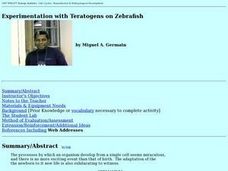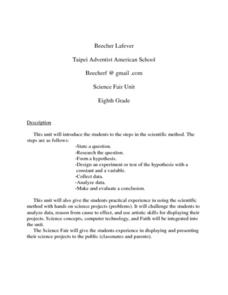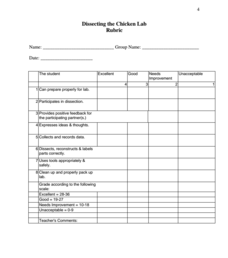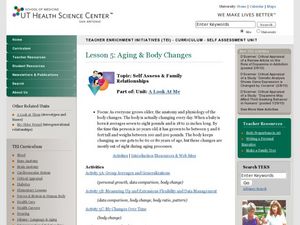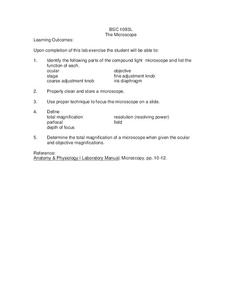Curated OER
Embryological Development Using Medaka Fish
High schoolers analyze and record major events that occur in the development of Medaka fish eggs from fertilization to hatching. In small group, students describe the processes involved, creating a timeline of the major events in the...
Curated OER
Experimentation with Teratogens on Zebrafish
Pupils compare mitosis and meiosis with regard to chromosome number in parent cells versus daughter cells, types of cells produced, total number of cells produced, and the number of divisions. In groups, identify and differentiate the...
Curated OER
Science Fair Unit
Eighth graders explore the scientific method. After choosing an approved science fair project, 8th graders go through the scientific method process. Students gather information to analyze data and evaluate a conclusion. They write a...
Curated OER
Skeletal Structures
Students relate the location and the function of individual skeletal parts. Students identify and discuss skeletal differences between species. Students identify and define related terminology. Students individually complete a written...
Curated OER
Red Mangroves Of Southern Florida
Students engage in a unit plan to examine the ecological background for the Mangroves of southern Florida. They conduct research using print and computer technology sources. They use the information in a number of other extension...
Curated OER
Genetics
Students explain the difference between dominant and recessive genes, identify what causes differences in the traits of parents and their offspring, and explain how sex is determined. They will also improve their reading and...
Curated OER
Aging & Body Changes
Students complete several activities that have to do with aging. In this body changes lesson students take group averages, measure flexibility and see their changes over time.
Curated OER
Classroom Identity
Students explore fingerprints. In this finger prints lesson, students investigate how to classify fingerprints. Students study large pictures of fingerprints and circle the patterns they know how to identify. Students then take their own...
Curated OER
Supermarket Science: The King Sooper Lab
Students read product labels, compare fat, sodium, and sugar contents of various food items. They work with a partner and often employ the assistance of the deli and bakery managers in a supermarket.
Curated OER
Our Lifeline Pump
Fourth graders, in groups, the exterior and interior of the human heart.
Curated OER
How Does Human Respiration Relate to Radon?
Students examine the role of human respiration and how it relates to radon. They identify damage to the lung from the exchange of carbon dioxide and oxygen. They work together to complete a lab activity and worksheet.
Curated OER
Prosthetic Design
High schoolers research characteristics of different body parts. Students design and sketch a prosthetic they developed. They share their idea with the class and complete a worksheet.
Curated OER
The Breathtaking Nature of the Urban Explosion, Part 4
Young scholars explore the respiratory system. They use a computer to monitor the respiratory rate of an individual. They determine residual oxygen levels in exhaled air. Students evaluate how internal 02 and C02 concentrations...
Curated OER
Viruses and Host Evolution
Students research viruses and their effects on the evolution of a rabbit population. They complete a teacher created worksheet of questions on their research. They present their research to classmates.
Curated OER
Mechanism of Our Eyes
Students study the eye as the organ of vision, They look at a drawing of the eyes and study the names of the parts. While working with a partner, they observe what happens when the lights are turned lower and lower. Finally, they look at...
Curated OER
The Microscope
In this microscope lesson students explore the compound light microscope. Students discover techniques concerning cleaning, storage and proper use of the microscope. Students discover the working parts of the compound light microscope as...
Curated OER
What Sticks Can Make You Sick
Young scholars study adhesins and their receptors. In this science inquiry lesson students experiment to find adherence and use agglutination to identify adhesins.
Other
Get Body Smart: Muscle Fiber Anatomy & Muscle Contraction Physiology
Brought to you by Get Body Smart, students can learn about muscle fiber anatomy and muscle contraction physiology through this easy-to-access tutorial. Sections include Fiber Location and Composition, Nerve Supply to Muscle Fibers,...
OpenStax
Open Stax: Anatomy & Physiology: Heart Anatomy
Students learn the anatomy and physiology of the human heart through text readings, illustrated diagrams, and self-checking review questions at the end.
OpenStax
Open Stax: Anatomy & Physiology: Physiology of Urine Formation
Focus on the physiology of the urinary system, and discover that different parts of the nephron utilize specific processes to produce urine: filtration, reabsorption, and secretion. Learn how each of these processes works and where they...
OpenStax
Open Stax: Anatomy & Physiology: Infant Adjustments Birth and Postnatal Stage
In this module, discuss the importance of an infant's first breath, and the physiological event that take place.
OpenStax
Open Stax: Anatomy & Physiology: The Adrenal Glands
Students learn about the location and structure of the adrenal glands, and find out the physiological effects of the hormones produced there.
OpenStax
Open Stax: Anatomy & Physiology: Organs With Secondary Endocrine Functions
Students learn about the organs with a secondary endocrine function, the hormones they produce, and the effects on human physiology.
OpenStax
Open Stax: Anatomy & Physiology: Hormones
Students will find out about the three major classes of hormones on the basis of chemical structure, and learn the role they play in human physiology.
Other popular searches
- Heart Anatomy and Physiology
- Anatomy and Physiology Web
- Plant Anatomy and Physiology
- Brain Anatomy & Physiology
- Basic Anatomy and Physiology
- Heart Anatomy Physiology
- Muscle Anatomy & Physiology
- Anatomy & Physiology 1
- Anatomy Physiology Digestion
- Anatomy & Physiology Models
- Anatomy Physiology Digestive
- Anatomy Physiology Wolf

